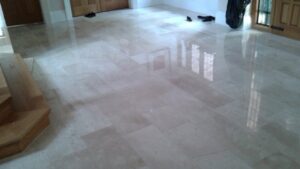In New Malden, this limestone floor had lost its finish. The surface had become dull, scratched, and stained and years of foot traffic and poor cleaning had taken a toll. The homeowners reached out to Fabritec Tile Cleaning for help. They wanted their floor restored to its former beauty. This case study details how Fabritec expertly cleaned, honed, and sealed the limestone, bringing it back to life.
Understanding Limestone
Limestone is a sedimentary rock, prized for its beauty and durability. However, it is porous. This porosity makes it prone to absorbing dirt, liquids, and stains. Limestone's soft surface also makes it susceptible to scratching and etching. Over time, if not correctly cared for, limestone floors will lose their natural beauty. In this case, the homeowners used common household cleaners, often containing strong acid or alkali ingredients. These cleaners had stripped away the protective seal and damaged the stone.
 Why Limestone Requires Professional Care
Why Limestone Requires Professional Care
Many homeowners are unaware of how delicate limestone can be. Standard cleaning solutions can do more harm than good. Professionals recommend non-acidic cleaners for limestone that won't etch or dull the surface. Restoring a limestone floor takes more than just cleaning—it requires careful, knowledgeable restoration techniques. That's why the homeowners in New Malden turned to Fabritec Tile Cleaning.
Inspection: Diagnosing the Issues
Fabritec began with a thorough inspection. The team noted significant sealer wear. Scratches ran across the surface. Etching from acidic spills had left the stone rough and pitted. A specific challenge arose from an etch mark caused by a damp oak beam resting on the floor. The oak’s tannins leached into the limestone, damaging the sealer and leaving a noticeable mark. The protective seal was worn, allowing dirt to penetrate the stone. The floor had lost its sheen and felt rough to the touch.
The existing sealer needed to be removed, repairs to fix the damage, and a new protective seal.
Preparing the Floor for Cleaning
Before beginning the cleaning process, Fabritec prepared the area. The client cleared the room of furniture and debris, ensuring the technicians had full access to every part of the floor. This also prevented accidental damage to furniture or decor during the cleaning process.
Next, they protected nearby walls, baseboards, and adjacent flooring with sheeting. Limestone cleaning solutions can sometimes splash, and this step ensures that the cleaning agents only touch the intended surface—the limestone floor.
Deep Cleaning: Restoring the Limestone's Surface
The next step was a deep clean to remove the existing sealer. Fabritec applied a cleaner and sealer remover explicitly designed for limestone. They allowed the cleaner to sit on the surface for several minutes, allowing it time to break down the sealer.
The team carefully worked the cleaner into the floor using a rotary scrubbing machine. The rotary motion helped lift the old sealer from the stone without scratching or damaging the surface.
Once the deep clean was complete, the limestone looked significantly better. The surface was clean, and free of the ld damaged sealer. However, the floor still needed more work to address the damage from scratches and etching.
Honing: Smoothing Out Scratches and Etching
After the deep clean, Fabritec focused on the scratches and etching. Limestone is a soft stone; years of use can leave behind small scratches and marks. The floor also had visible etching from acidic cleaners and spills in this case.
To fix this, Fabritec used diamond polishing pads to hone the floor. This process involves smoothing out the surface using a series of diamond pads with increasing grit levels. They began with a coarser pad to remove the deeper scratches and etching. Then, they moved to finer pads to create a smooth, even surface.
Honing removes imperfections and restores the stone’s texture. By the end of the honing process, the limestone had regained its smooth, natural feel. However, the team still had one more step to go before the restoration was complete.
Sealing: Protecting the Limestone for the Future
The final step in the restoration process was sealing the limestone floor. Limestone is a porous stone that can easily absorb liquids, dirt, and stains if left unprotected. Sealing creates a protective barrier that helps prevent this.
Fabritec applied a high-quality topical sealer. This provides long-lasting protection while maintaining the stone's natural look and feel.
The sealer protected the limestone from future spills and stains, making it much easier for homeowners to maintain the floor. It also ensured that the floor’s newly restored surface would stay beautiful for years to come.
The Results: A Stunning Transformation
After sealing, Fabritec allowed the floor to cure for several hours. The homeowners were thrilled with the results. Their limestone floor, which had looked dull and damaged, now had a fresh, clean appearance. The surface was smooth, the colours were vibrant, and the soft sheen added an elegant touch to the space.
More importantly, the floor was protected from future wear and tear. With the new seal, the homeowners could rest easy knowing that their floor would stay beautiful with regular maintenance.
Homeowner's Reaction
We were amazed at the difference after Fabritec finished with our limestone floors. They’d been looking tired and dull for years, but after the cleaning and sealing, they look brand new. The team was super friendly and took the time to explain each step. We’re so happy with the results!
Mrs. P – New Malden
Lessons from the Restoration
This case study highlights the importance of professional care for limestone floors. Limestone is a delicate material that requires specific cleaning techniques and products. As the homeowners in New Malden learned, using the wrong cleaner can damage the stone.
Professional cleaning and restoration services, like those provided by Fabritec, are essential for maintaining the appearance and durability of limestone. From the deep clean to the final sealing, every step of the process required specialized knowledge and tools.
Prevention and Aftercare Tips for Limestone Floors
Fabritec provided them with guidelines for maintaining the floor and preventing future damage.
- Specialist cleaners for topical sealers are formulated to include a small amount of sealer. This helps maintain and rebuild the sealer's finish rather than degrading it. Harsh chemicals like vinegar, bleach, or ammonia can damage limestone by etching the surface and breaking down the protective layer. Using the recommended cleaner from the sealer manufacturer ensures that the floor's protective finish is maintained while effectively cleaning the surface without causing harm.
- Wipe Spills Immediately: Because limestone is porous, spills can quickly soak into the stone and cause stains. To prevent staining, wipe up any spills as soon as they happen.
- Regular Cleaning: Sweep or vacuum the floor regularly to remove dirt and debris. This prevents dirt from being ground into the surface, which can cause scratches over time.
- Reapply Sealer as Needed: Over time, the protective seal on the limestone will wear away. To protect the floor from stains and spills, reapply a sealer every 1-2 years.
- Professional Maintenance: Hire professionals who specialize in natural stone care for deep cleaning and repairs. Regular professional cleaning will keep your limestone floor looking its best and extend its lifespan.
Conclusion
Fabritec Tile Cleaning successfully transformed a worn and damaged limestone floor in New Malden. By carefully cleaning, honing and sealing the floor, they restored its natural beauty and ensured its longevity. This case study demonstrates the importance of professional care for delicate materials like limestone. With proper maintenance, homeowners can enjoy their limestone floors for many years to come.
Trending FAQs About Limestone Floor Care:
What is the best cleaner for limestone floors?
A non-acidic, pH-neutral cleaner designed for natural stone is ideal for limestone floors.
Can I use vinegar on limestone tiles?
No, vinegar and other acidic cleaners can damage limestone by causing etching and dulling the surface.
How often should I seal my limestone floor?
Limestone floors should be resealed every 1-2 years, depending on foot traffic and exposure to moisture.
Why does my limestone floor look dull?
Dullness can be caused by a buildup of dirt, improper cleaning methods, or wear on the sealant. Professional cleaning and resealing can restore its shine.
How do you remove stains from limestone?
A poultice can be used to draw out tough stains, but to avoid damaging the stone, it's best to consult a professional.
The post Marble Floor Restoration New Malden is brought to you by Limestone Cleaning Surrey
The Article Limestone Floor Cleaning New Malden appeared first on https://fabritec.org
The Article Limestone Floor Cleaning New Malden Was Found On https://limitsofstrategy.com


Your exploration of limestone care in New Malden raises some important considerations about maintaining natural stone surfaces and the implications of our cleaning choices. It’s interesting to see how easily homeowners can overlook the specific needs of their materials, often opting for off-the-shelf products that promise quick results but can do more harm than good.